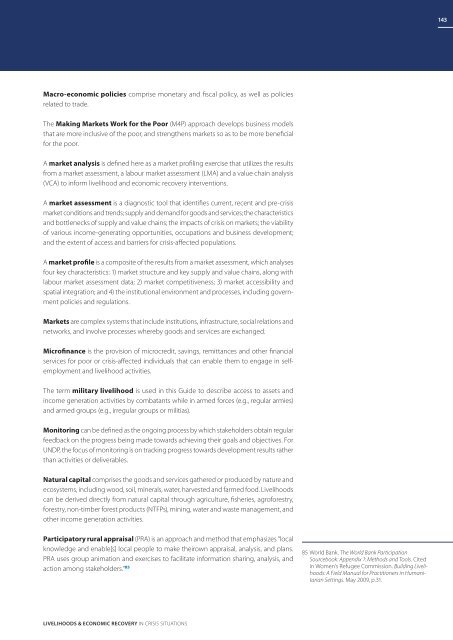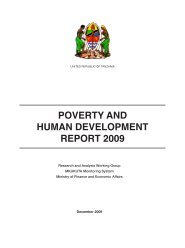Download PDF (4.08 MB) - ReliefWeb
Download PDF (4.08 MB) - ReliefWeb
Download PDF (4.08 MB) - ReliefWeb
You also want an ePaper? Increase the reach of your titles
YUMPU automatically turns print PDFs into web optimized ePapers that Google loves.
143<br />
Macro-economic policies comprise monetary and fiscal policy, as well as policies<br />
related to trade.<br />
The Making Markets Work for the Poor (M4P) approach develops business models<br />
that are more inclusive of the poor, and strengthens markets so as to be more beneficial<br />
for the poor.<br />
A market analysis is defined here as a market profiling exercise that utilizes the results<br />
from a market assessment, a labour market assessment (LMA) and a value chain analysis<br />
(VCA) to inform livelihood and economic recovery interventions.<br />
A market assessment is a diagnostic tool that identifies current, recent and pre-crisis<br />
market conditions and trends; supply and demand for goods and services; the characteristics<br />
and bottlenecks of supply and value chains; the impacts of crisis on markets; the viability<br />
of various income-generating opportunities, occupations and business development;<br />
and the extent of access and barriers for crisis-affected populations.<br />
A market profile is a composite of the results from a market assessment, which analyses<br />
four key characteristics: 1) market structure and key supply and value chains, along with<br />
labour market assessment data; 2) market competitiveness; 3) market accessibility and<br />
spatial integration; and 4) the institutional environment and processes, including government<br />
policies and regulations.<br />
Markets are complex systems that include institutions, infrastructure, social relations and<br />
networks, and involve processes whereby goods and services are exchanged.<br />
Microfinance is the provision of microcredit, savings, remittances and other financial<br />
services for poor or crisis-affected individuals that can enable them to engage in selfemployment<br />
and livelihood activities.<br />
The term military livelihood is used in this Guide to describe access to assets and<br />
income generation activities by combatants while in armed forces (e.g., regular armies)<br />
and armed groups (e.g., irregular groups or militias).<br />
Monitoring can be defined as the ongoing process by which stakeholders obtain regular<br />
feedback on the progress being made towards achieving their goals and objectives. For<br />
UNDP, the focus of monitoring is on tracking progress towards development results rather<br />
than activities or deliverables.<br />
Natural capital comprises the goods and services gathered or produced by nature and<br />
ecosystems, including wood, soil, minerals, water, harvested and farmed food. Livelihoods<br />
can be derived directly from natural capital through agriculture, fisheries, agroforestry,<br />
forestry, non-timber forest products (NTFPs), mining, water and waste management, and<br />
other income generation activities.<br />
Participatory rural appraisal (PRA) is an approach and method that emphasizes “local<br />
knowledge and enable[s] local people to make theirown appraisal, analysis, and plans.<br />
PRA uses group animation and exercises to facilitate information sharing, analysis, and<br />
action among stakeholders.” 85<br />
85 World Bank. The World Bank Participation<br />
Sourcebook: Appendix 1: Methods and Tools. Cited<br />
in Women’s Refugee Commission. Building Livelihoods:<br />
A Field Manual for Practitioners in Humanitarian<br />
Settings. May 2009, p.31.<br />
Livelihoods & Economic Recovery in Crisis Situations





